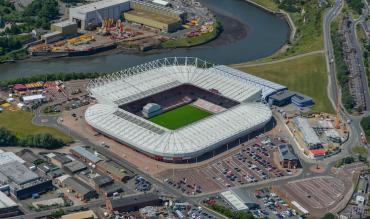-
Attendances at Championship stadiums are booming with many games sold out
-
These grounds easily have the capacity to handle the demand for England's second tier
-
These are the stadiums in use during the 2023/24 EFL Championship season
THE all-encompassing nature of our English Football League Championship embraces stadiums with capacities ranging from 12,021 right up to 49,000.

Our Championship predictions for this coming season tip another broad battle at both ends of the table so we can once again expect grounds to be packed from Plymouth to Sunderland.
In this blog we rank the respective club home grounds in terms of their size with other pertinent facts and figures added in for good measure…
24th) The AESSEAL New York Stadium - Rotherham United
-
Capacity: 12,021
-
Year opened: 2012
-
Record attendance: 11,758 versus Sheffield United on 7th September 2013.
-
2023/24 average home attendance: 10,737
23rd) Home Park – Plymouth Argyle
-
Capacity: 17,000
-
Year opened: 1903
-
Record attendance: 43,596 versus Aston Villa on 10th October 1936.
-
2023/24 average home attendance: 16,416
22nd) MATRADE Loftus Road Stadium – Queens Park Rangers
-
Capacity: 18,193
-
Year opened: 1904 for Shepherd’s Bush FC, 1917 for Queens Park Rangers
-
Record attendance: 35,353 versus Leeds United on 27th April 1974.
-
2023/24 average home attendance: 16,667
21st) The Den – Millwall
-
Capacity: 20,146
-
Year opened: 1993
-
Record attendance: 20,093 versus Arsenal on 10th January 1994.
-
2023/24 average home attendance: 16,425
20th) Swansea.com Stadium – Swansea City
-
Capacity: 21,088
-
Year opened: 2005
-
Record attendance: 20,972 versus Liverpool on 1st May 2016.
-
2023/24 average home attendance: 16,324
19th) Vicarage Road Stadium – Watford
-
Capacity: 22,200
-
Year opened: 1922
-
Record attendance: 34,099 versus Manchester United on 3rd February 1969.
-
2023/24 average home attendance: 18,676
18th) Deepdale – Preston North End
-
Capacity: 23,404
-
Year opened: 1878
-
Record attendance: 42,684 versus Arsenal on 23rd April 1938.
-
2023/24 average home attendance: 16,732
17th) The John Smith’s Stadium – Huddersfield Town
-
Capacity: 24,121
-
Year opened: 1994
-
Record attendance: 24,263 versus Liverpool on 20th October 2018.
-
2023/24 average home attendance: 19,289
16th) MKM Stadium – Hull City
-
Capacity: 25,586
-
Year opened: 2002
-
Record attendance: 25,512 versus Sunderland on 28th October 2006.
-
2023/24 average home attendance: 21,604
15th) The Hawthorns - West Bromwich Albion
-
Capacity: 26,850
-
Year opened: 1900
-
Record attendance: 64,815 versus Arsenal on 6th March 1937.
-
2023/24 average home attendance: 23,933
14th) Ashton Gate Stadium – Bristol City
-
Capacity: 27,000
-
Year opened: 1887 for Bedminster FC, 1904 for Bristol City.
-
Record attendance: 43,335 versus Preston North End on 16th February 1935.
-
2023/24 average home attendance: 22,681
13th) Carrow Road – Norwich City
-
Capacity: 27,359
-
Year opened: 1935
-
Record attendance: 43,984 versus Leicester City on 30th March 1963.
-
2023/24 average home attendance: 25,962
12th) St. Andrew’s @ Knighthead Park– Birmingham City
-
Capacity: 29,409
-
Year opened: 1906
-
Record attendance: 66,844 versus Everton on 11th February 1939.
-
2023/24 average home attendance: 20,480
11th) Portman Road – Ipswich Town
-
Capacity: 29,673
-
Year opened: 1884
-
Record attendance: 38,010 versus Leeds United on 8th March 1975.
-
2023/24 average home attendance: 29,242
10th) bet365 Stadium – Stoke City
-
Capacity: 30,089
-
Year opened: 1997
-
Record attendance: 30,022 versus on 17th March 2018.
-
2023/24 average home attendance: 22,333
9th) Ewood Park – Blackburn Rovers
-
Capacity: 31,367
-
Year opened: 1881
-
Record attendance: 61,783 versus Bolton Wanderers on 2nd March 1929.
-
2023/24 average home attendance: 14,925
8th) King Power Stadium – Leicester City
-
Capacity: 32,262
-
Year opened: 2002
-
Record attendance: 32,242 versus Sunderland on 8th August 2015.
-
2023/24 average home attendance: 31,053
7th) St Mary’s Stadium – Southampton
-
Capacity: 32,384
-
Year opened: 2001
-
Record attendance: 32,363 versus Coventry City on 28th April 2012.
-
2023/24 average home attendance: 29,242
6th) Coventry Building Society Arena – Coventry City
-
Capacity: 32,609
-
Year opened: 2005
-
Record attendance: 32,128 England Lionesses v Italy on 19th February 2023.
-
2023/24 average home attendance: 24,801
5th) Cardiff City Stadium – Cardiff City
-
Capacity: 33,280
-
Year opened: 2009
-
Record attendance: 33,280 Wales versus Belgium on 12th June 2015.
-
2023/24 average home attendance: 20,996
4th) Riverside Stadium – Middlesbrough
-
Capacity: 34,742
-
Year opened: 1995
-
Record attendance: 35,000 England versus Slovakia on 11th June 2003.
-
2023/24 average home attendance: 26,831
3rd) Elland Road – Leeds United
-
Capacity: 37,608
-
Year opened: 1897 for Holbeck Rugby Club, 1919 for Leeds United.
-
Record attendance: 57,892 versus Sunderland on 15th March 1967.
-
2023/24 average home attendance: 35,895
2nd) Hillsborough – Sheffield Wednesday
-
Capacity: 39,732
-
Year opened: 1899
-
Record attendance: 72,841 versus Manchester City on 17th February 1934.
-
2023/24 average home attendance: 25,741
1st) The Stadium of Light – Sunderland
-
Capacity: 49,000
-
Year opened: 1997
-
Record attendance: 48,335 versus Liverpool on 13th April 2002.
-
2023/24 average home attendance: 40,993
*Credit for all of the photos in this article belongs to Alamy*


